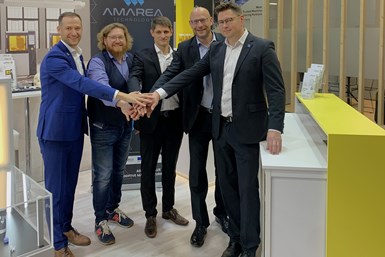Lithoz Invests in AMAREA 3D Printing Technology Which Combines Up to Six Different Materials in a Single Print Run
The company is looking to actively support a new dimension of 3D printed, functionally graded components.
Celebrating the formal signing of the acquisition at Formnext, (from left to right) Robert Johne, Dr. Johannes Benedikt, Steven Weingarten, Dr. Johannes Homa and Lutz Gollmer. Source: Lithoz
After almost a decade of productive cooperation with Dresden-based Fraunhofer IKTS, Lithoz has officially acquired a strategic share in that company’s spin-off AMAREA Technology. As a specialist in multimaterial 3D printing, AMAREA has developed a 3D printing technology that processes up to six different materials in one single print run. Its Multi Material Jetting (MMJ) technology is said to unlock new multidimensional combinations of various ceramics, metals, polymers and composites in both individual parts and functionally graded components.
Inspired by LP injection mlding, the high-filled thermoplastic base material developed and supplied by AMAREA Technology is dispensed drop by drop. Due to the nanoliter volume, the drops solidify in a fraction of a second, considerably speeding up the entire printing process. Because of the selective droplet-based printing technology, parts achieve a considerably higher level of accuracy than material extrusion processes, for example. This enables a material change to take place every 200 micrometers so that highly functionalized components can be additively manufactured.
“We had a great response to our multimaterial, 3D printed heaters and igniters for high temperatures above 1000 degrees, which enable applications in harsh environments, too,” says Steven Weingarten, AMAREA Technology CEO.
The resulting functionally graded components have a far higher density and better surface quality than those printed using other material extrusion techniques, for instance. Beyond that, it is also possible to exactly define requested porosities at any selected position within the component.
More than 25 different materials have already been introduced to the MMJ production technique, with the portfolio continuously growing, while important parameters such as filling levels, porosity, gradient, layer height and density can be freely and specifically defined.
“With our proud acquisition of a strategic share in AMAREA Technology, we can’t wait to see how our ultraprecise Lithoz LCM technology and AMAREA Technology’s MMJ system pointing on maximum material diversity will work hand-in-hand to unlock previously unachievable potentials,” says Dr. Johannes Homa, Lithoz CEO. “This will create the next generation of multimaterial 3D printed applications from the semiconductor to aerospace industry — as first inquiries have already proven.”
AMAREA Technology is pleased with the partnership. “Lithoz’s global reputation and its successful path to becoming the market leader in ceramic 3D printing are a model for the mission we are now taking in the field of multimaterial 3D printing,” Weingarten says. “We would like to express our gratitude to Johannes Homa and Johannes Benedikt for their trust and look forward to the exciting journey together.”
Related Content
-
Robot Vs. Gantry for Large-Format Additive Manufacturing (Includes Video)
Additive Engineering Solutions, specialist at 3D printing very large parts and tools on gantry machines, now also uses a robot for large-format AM. Here is how the robot compares.
-
Savage Automation Delivers 3D Printed Commercial Manufacturing Aids
The company's approach to designing end-of-arm tooling and other devices has evolved over the years to support longevity and repairs.
-
8 Social Media Posts About Additive Manufacturing: AM Radio #34
Cost savings, modifications, large-format AM and more. In this episode of AM Radio, we discuss what people are saying about additive manufacturing on social media.












